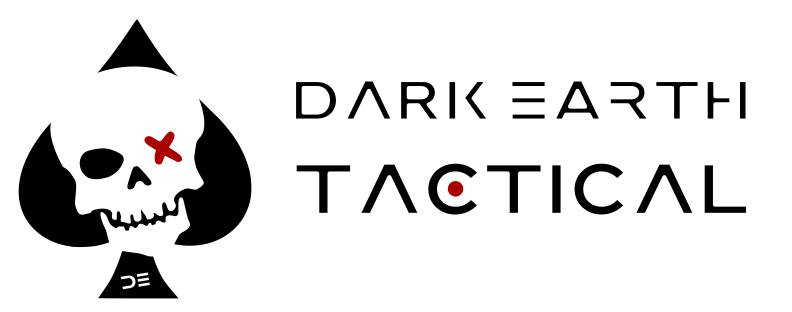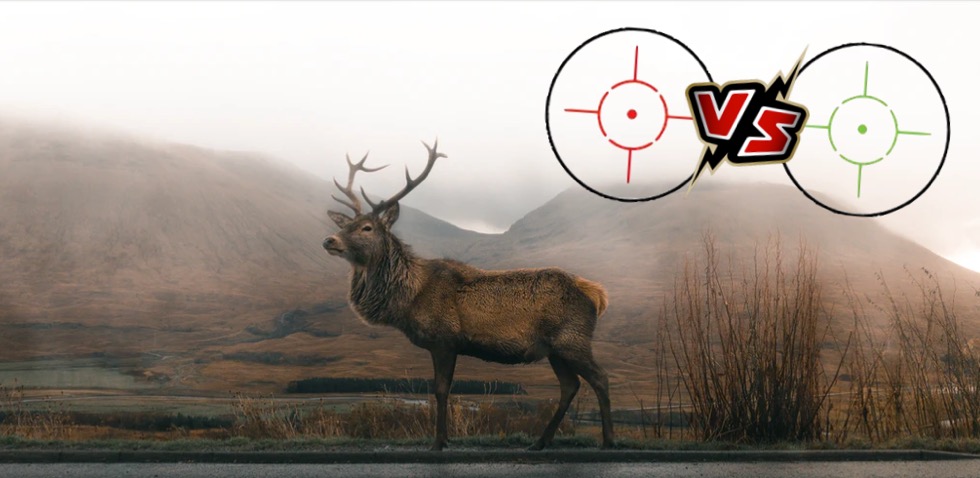Have you ever wondered why the modern reflex sight comes with a red or green illuminated reticle, or in some cases both? Well unbeknown to many, the difference in dot colours are each designed with their own unique advantages. So which one should you choose, and when would you use one dot colour over the other?
Science will agree that red dots catch the eye faster and would be more suited for faster target acquisition during the day and when observing a target in a green environment. Green is supposedly more relaxing on the eye, lessening the effects of eye fatigue when used for prolonged periods, while also proving to be the superior colour selection for night time use and power saving.
While the differences between red and green sights are almost negligible under most circumstances, careful selection may prove useful to the avid shooter who uses his equipment under a multitude of scenarios and environments. For this reason, it is beneficial to understand the pros and cons of each.
Red Dot Advantages & Superiority
The red dot is certainly the more common option of the two, and has a few advantages of its own.
Speed of Acquisition
The main advantage of an illuminated red dot over green is acquisition speed; it catches the eye faster and therefore means a faster sight picture and target acquisition. This is because red rays of light have a very high wavelength and a small frequency, which strikes your eye faster than green light.
Background Complexity
This one speaks for itself. When the optic is used in jungle or bushy environments, a green dot is far more likely to “wash out” when observed against a green background. An example can be seen in the image below. A red dot is clearly the better choice under this environment.
Some may flip this advantage, arguing that a red dot may get lost in certain urban environments; amongst vehicle lights and street lamps etc, but I have never had any issues in this department. So I am giving the red dot the advantage in defeating complex backdrops.

Green Dot Advantages & Superiority
Green dot sights are the least common of the two, and are often found in dual red/green dot optics.
Less Eye Strain
The most established advantage of the green dot over red is that it puts less strain on the eye. This often produces a more pleasant shooting experience amongst older shooters with weaker vision, and when used for extended periods of time.
The operation of the eye is largely muscular, and any excessive activity will tire it out. The shorter wavelength and higher frequency of green light is therefore less strenuous on the eye.

Power Saving
The human eye is far more receptive to green light than red. This is because green light stimulates two of the three kinds of cones in the human eye almost equally. This means that if you were to look at two dots of light – red & green – at the same power level, the green dot will appear much brighter. This means that lower power levels can be used for green, saving battery power.
Eyes with Astigmatism
Astigmatism is a type of refractive error in which the eye does not focus light evenly on the retina. In simpler terms, it can be referred to as blurred vision. A shooter who is astigmatic will most likely notice a distorted or blurred reticle when looking through a reflex sight.
Green dots are known to be the better choice for older shooters or for those with blurred vision. So if you suffer with Astigmatism, it is recommended to use a green dot over a red. Why? Simply because green light is softer and easier on the eye, and therefore less likely to distort and cause headaches and discomfort.
Choose a High Quality Optic over Colour
A lot of the time, a green dot sight, or dual red/green dot sight is found on cheap Chinese-made optics. There are many issues that a shooter may be faced with when buying cheap low-grade optics. These problems include poor durability and lack of robustness, an inability to hold a zero, and dot distortion and bloom.
Bloom can be defined as an effect where a dot sight is damaged or cheaply made and the dot becomes distracting and radiant, blooming out into the target and appearing larger and more distorted than it should.
Another downside to the dual red/green dot over a simple red or green only dot, is that they feature a narrower range of brightness settings. For example, a quality red dot may feature 10 different brightness settings, while a quality red/green dot may feature only 5 brightness setting on each colour; with 10 setting in total. In simpler terms, red/green dot combos are not always as bright as red only optics, which could become less than ideal on a bright day.
Dot Sights & Night Vision Devices
If you are planning on using a weapon sight along with a helmet mounted night vision google, then I’d recommend placing less emphasis on colour illumination and rather select a holographic sight over a reflex sight.
The holographic sight is more expensive, but is optically, electronically, and otherwise superior to reflex sights, offering advanced features that are far more suitable when used alongside night vision devices.
- The holographic sight is designed to be used with night vision and NVG intensifier tubes, with no halo effect, whereas the reflex sight is simply too bright.
- The holographic’s projected reticle is also visible to only the operator and produces no muzzle-side signature, meaning that light cannot be seen from the shooting end.
For more information on reflex vs. holographic sights, read the following blog: Semi-Automatic Rifle Scopes: Choosing The Right Optic For You
Conclusion
All things considered, the decision whether to choose a red or green dot sight comes down to personal preference of the shooter. If you already own a red dot optic, there is no need to run out and purchase a green dot optic, because the difference under most applications is only slight.
If you own both optics, or if you own an optic with dual red/green illumination, then you should follow the advice given above. But at the end of the day, the chances are you’ll manage just fine with either device.
If you enjoyed reading about the differences between red & green dot sights, please comment below. We’d love to hear your thoughts and experiences between the two.


11 thoughts on “Reflex Sights: The Red vs. Green Dot & Which is Better”
I was very confused on my HS510-C Red Dot Sight. After this review I’m happy with this purchase. Thank You
Excellent Breakdown : Compliments to the Author…. For research , knowledge , & a well laid out article ….. Quite Rare these days .
Great post, thanks! When I stared at the red square for 30 seconds and switched to the white, the background of the white appeared blue to me. Dunno why lol.
Me too! It was a very bright sky blue when I did it. The experiment clearly works, but I wonder why for some of us it’s not green at all, but blue? It’s not even a greenish blue, it’s a very light and bright blue. Interesting.
Bluish-green or cyan. You were probably expecting dark green or rifle green.
Part of it comes down to genetics. Different people have different proportions of cones in their retinas.
Looked blue to me too.
Most of what you offer here is outstanding, but… red and green photons both travel at the very same speed of light, so they will both arrive at the exact same time (as if you could notice when photons are traveling at almost 300k m/s. I think you are confused regarding wavelengths of red and green… https://www.britannica.com/science/color/The-visible-spectrum shows green at a higher frequency than red. And, … green photons being higher frequency, they’ll will have more energy (thus stimulative power). I am fairly certain that the difference in energy is responsible for the apparent brightness. I have never heard that green photons stimulate more than one type of cone where red only stimulates one. It’s more likely that every frequency photon has some stimulative effect on every cone, but red cones are more sensitive to red, green to green, etc. You might want to check on that. It’s most likely the energy (which comes from the frequency), not the wavelength.
Just getting an education on running red or green dot with night vision. This was very educational.
Thanks
I also saw light blue 💙
This article is on par with international information 👏 👌
It would have been nice to see recommended or at least available optics for South Africa. Another plus would have been to have 3 different backgrounds for the dot comparison.